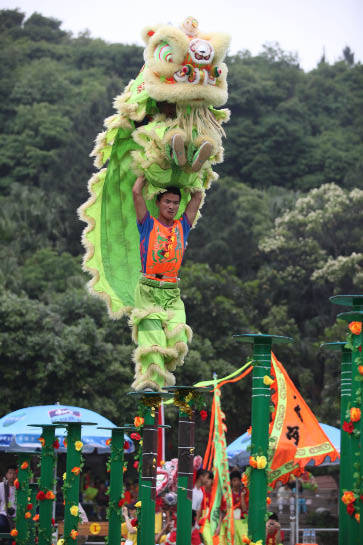|
|
 |
|
The southern lion is nonrepresentational in its appearance. Photos by China Foto Press |
The performance style of southern lion dance is based on the martial arts, making it quite different from the northern genre. It's the martial arts background that renders dancers capable of executing the most challenging movements. Hence, the southern lion dance is usually performed by kung fu players.
The lead dancer plays the most important part in the performance since in addition to making his dance moves he must operate some levers inside the lion's head to open and close its eyes and mouth or twist and flap its ears. The lion's head, with its movable ears, eyelids and mouth, is vividly expressive. Performers often start the show with imitating a sleepy lion which stumbles and soon falls into sleep. But bothered by a flea, it then wakes up, scratches, sniffs and begins to play with the audience. During the interaction with the crowd, performers dance in freestyle footwork without a standard set of steps. Nevertheless, the footwork is still derived from a lion's movements and shows the buoyancy and precision of kung fu.
The lion dance is mobile and as dancers and band pass and play outside shops and restaurants, the audience, especially business owners, traditionally "feed" the lion with red envelopes containing money, believing this will bring prosperity to their business. It is also, of course, a reward for the performers' hard work.
In some areas, the custom is to feed the lion with lettuce that contains some money. This is called "pick the greens." The excited crowd hangs the lettuce high on a long stick and holds it in front of the lion as if to tempt it to jump. The lion tries its best to get the treat and this introduces the feat the audience is waiting for: the dancer in the rear raises the other one up to snatch the lettuce prize. Sometimes, the lettuce is so high that all members in the dance troupe will participate in the performance. Dozens of people form a human pyramid and only the most skillful martial artist is able to reach the lettuce while animating the heavy lion head.
Having got the lettuce in its mouth, the lion swallows the red envelope but spits out the vegetable, scattering the leaves over the cheerful crowd, symbolizing that blessings are in stall for all. In the end, the performer also unfurls a scroll expressing best wishes written in Chinese calligraphy. If the music has been loud and the firecrackers effective, evil spirits are driven away and good fortune has a clear path.
Today's lion dance is a folk art that integrates acrobatics and martial arts together while attaching more importance to the artistry in the lion's expression. In 2006, lion dance was approved as a national intangible cultural heritage by the Chinese government. Chinese immigrant communities also contribute a great deal to keeping this art alive by maintaining the tradition while living abroad. Quite a few foreigners have been impressed by it and taken a personal interest in learning the dance. Lion dance competitions are held in countries all over the world. | 